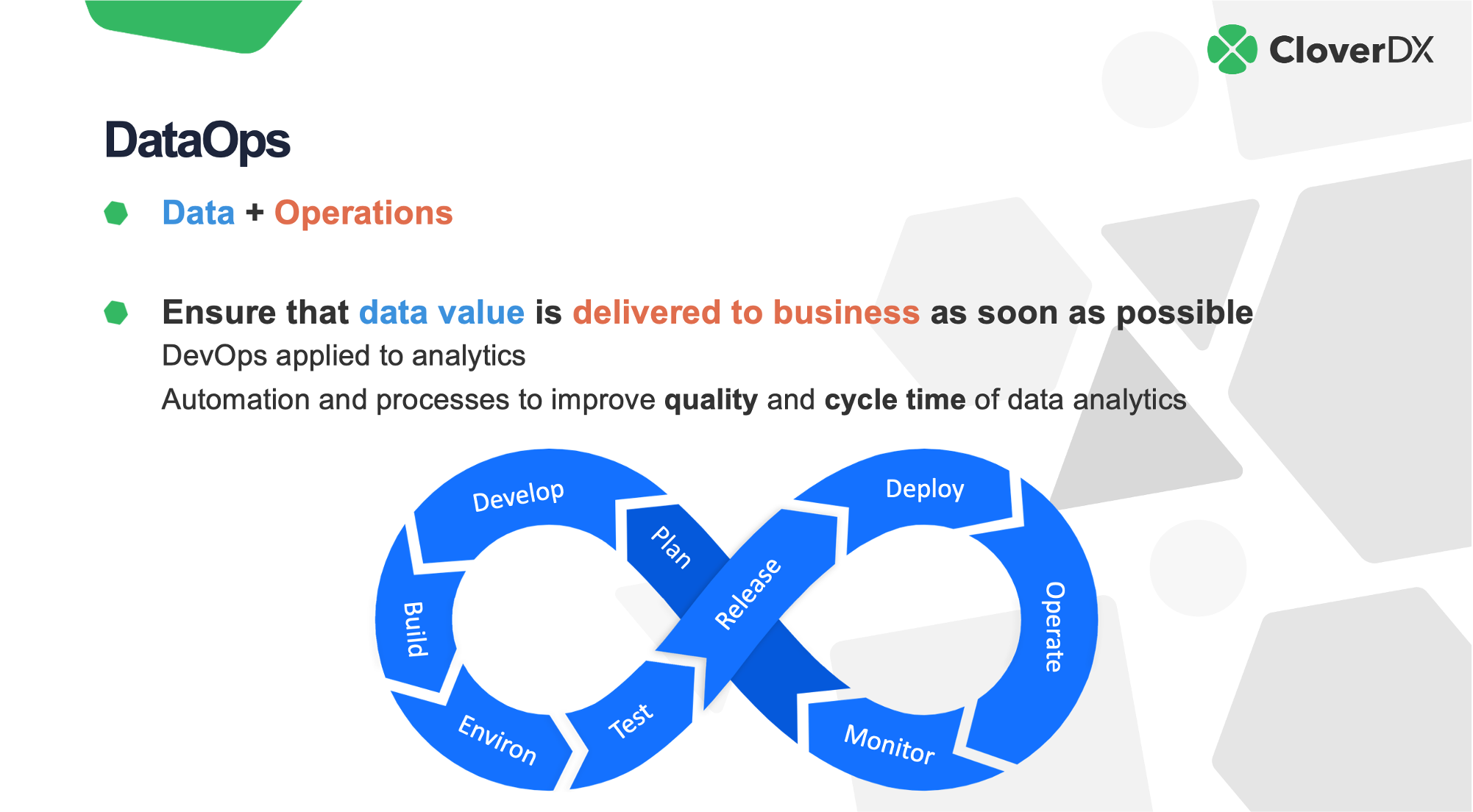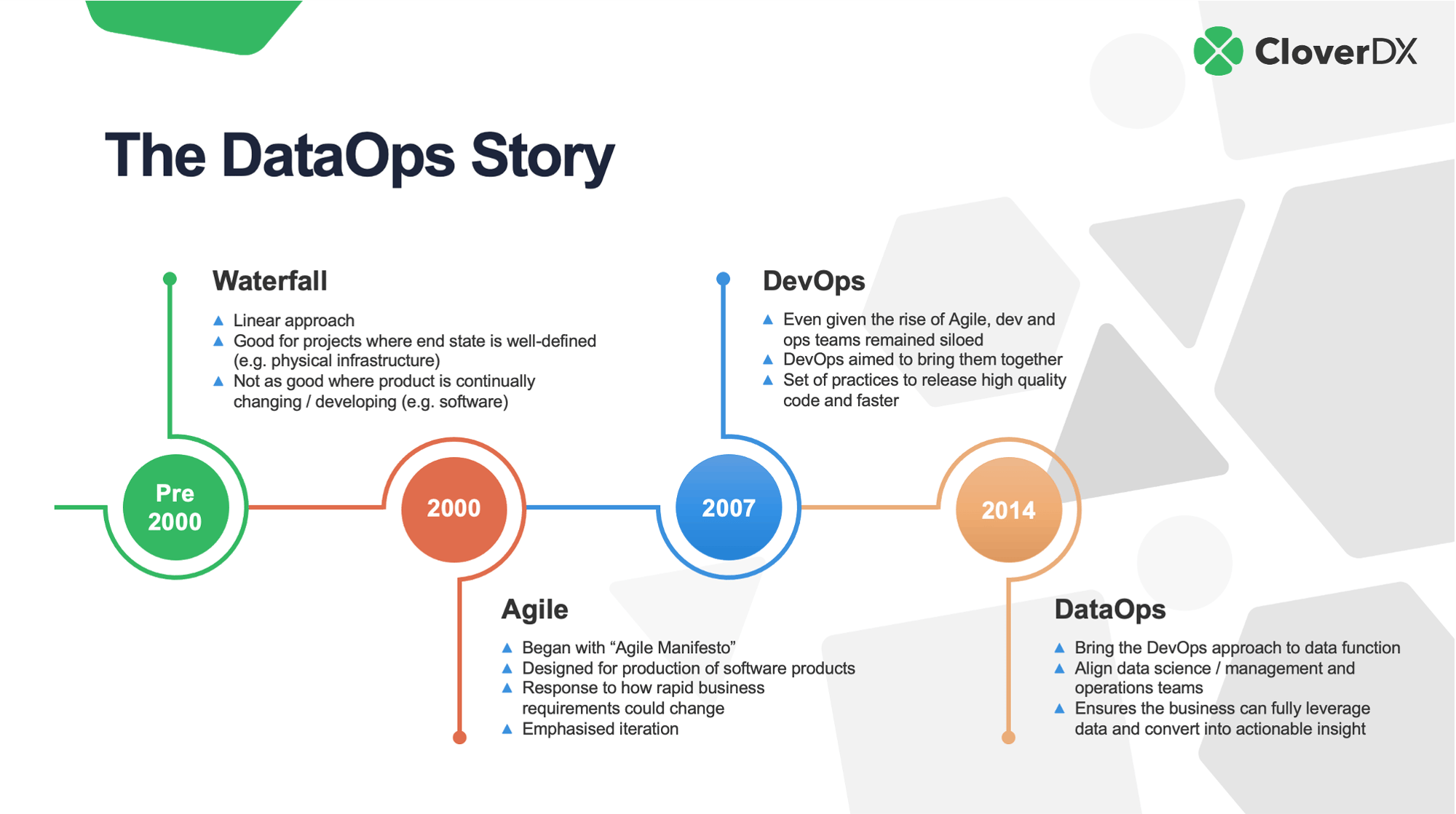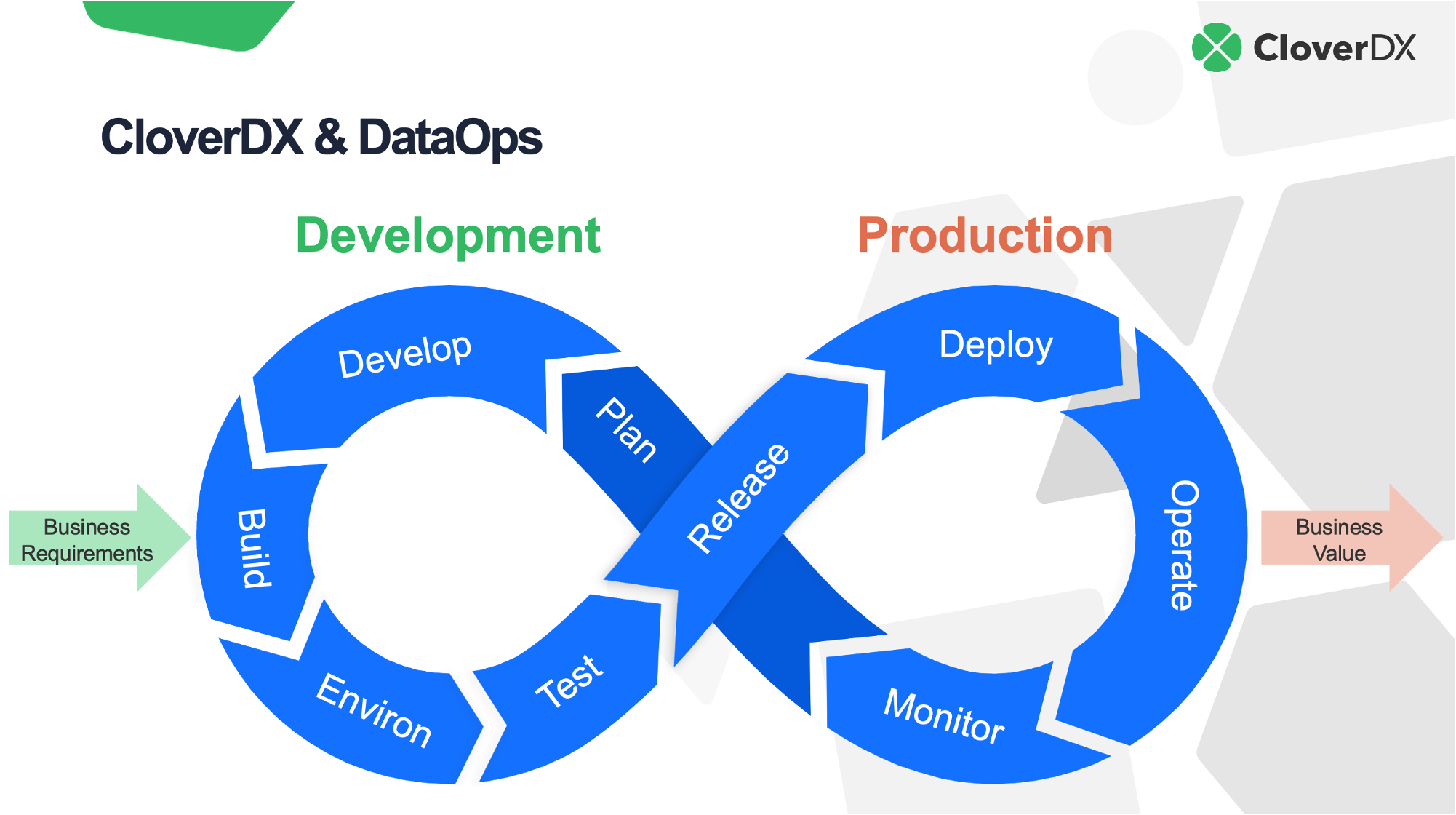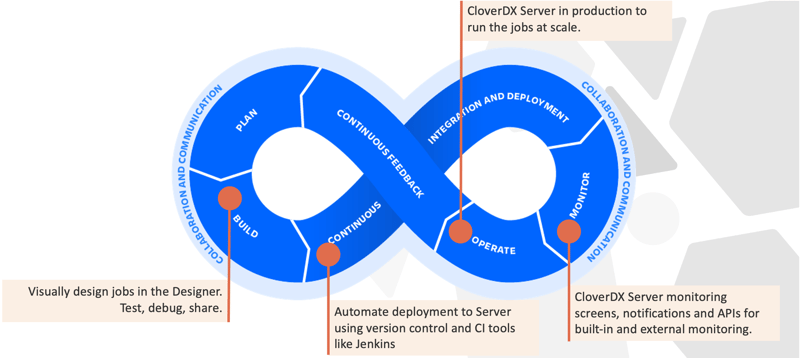Do your data projects lack agility and take an age to move forward?
Well, DataOps could be the missing piece of the puzzle.
After all, there’re plenty of advantages to DataOps, and here at CloverDX we’ve worked alongside many organizations who have leveled up their data projects using it.
So let’s take a deep-dive and explore what DataOps is and how a business like yours can benefit.
What is DataOps? Our definition
Before we go any further, let’s clarify the term so that we’re on the same page.
Here’s our definition of DataOps:
DataOps is a process-driven, automated approach to data delivery and analytics. It uses the agile approach between data owners and technical teams to improve quality while reducing cycle times. It borrows methods from DevOps to bring similar improvements, and isn’t tied to any one tool or technology – it’s more an amalgamation of culture, approach and methodology.
Below is an image to show what DataOps looks like as a process.

DataOps started gaining traction in 2014 by bringing a DevOps approach to data. By aligning data science and data management with operation teams, it empowered businesses to get more value from their data so they could convert it into actionable insights.
Below is a more detailed timeline for the DataOps story.

There's been widespread adoption of DataOps. Businesses such as Facebook, Netflix, and Uber all use DataOps to better leverage their data.
More specifically, Facebook used Hive and DataOps to democratize its data. This allowed its team members, and even non-technical business users, to independently extract data without support.
Debunking misconceptions (what DataOps isn’t)
To help us better understand what DataOps is, let's debunk some popular misconceptions.
- DataOps isn't a technology. That said, there are certain technologies that commonly support the implementation of DataOps. For example, collaboration tools and data automation tools (we'll cover this in more detail later). Instead of a technology, it makes sense to think of DataOps as a methodology that combines automation, continuous monitoring and involvement from both technical and business teams.
- DataOps is restricted to either 'big data' or advanced data science applications. This isn't the case. The scale of the data you’re working with doesn’t affect whether you can use DataOps or not, and you can use a wide range of tools to implement DataOps.
- DataOps is just DevOps for data. Rather, DataOps combines Agile development and DevOps, as well as continual maintenance and monitoring. Think of it as a water pipeline; your goal is to keep the water flowing in spite of all the plumbing work you carry out.
What do you need for DataOps?
To begin implementing DataOps in your organization, there are three crucial areas to establish. These are:
- People and Culture. This is the foundation for DataOps. You’ll need buy-in from stakeholders to ensure the business's requirements are understood, and to solidify the will to work through challenges as they present themselves. The different stakeholders fall into four different groups: business users, data preparers, data suppliers, and data consumers.
How do you create an environment that works for both data engineers and your domain experts? It involves taking some of the concepts of DevOps to increase efficiency. This clip is from our webinar From Old School Data Pipelines to DevOps and DataOps
- Processes. Next, you’ll need to build the framework for processes. Part of this is establishing which staff members are ‘RACI’ (responsible, accountable, consulted, and informed). This will bring clarification around roles and responsibilities, which is crucial as there will be cross-functional and cross-departmental processes with DataOps. Those participating in your DataOps project will also need training in DataOps.
- Technologies. Finally, you’ll want to look at tools. Automation, testing, and orchestration are all important here. You’ll want to consider tools like Trello to support Agile delivery, Slack for collaboration, CircleCI for automation, and Puppet to manage your infrastructure as code. A platform like CloverDX will give you the support you need to automate testing, increase deployment frequency, control metadata, monitor processes, and improve collaboration. We'll take a closer look at exactly how CloverDX can help later.
Watch the video below for a great overview of DataOps. Lars does a good job of showing you what DataOps looks like in practice and how it can help break down siloes in your organizaton.
Now, let’s explore why so many organizations choose to embrace DataOps.
DataOps benefits
By improving the quality and reducing the time of data analytics, as you can imagine, things get done much more quickly. This means businesses can move faster and more accurately to unlock value in their data.
More specifically, the benefits of DataOps include:
- Rapid error catching. With DataOps, output tests catch incorrectly processed data quickly. This is useful as it improves data quality, and prevents errors going downstream where they can create further (often costly) issues for your business.
- Immediate insights. Because you're accelerating your data operations and data analytics, you can see insights in the data very quickly. This is helpful for sectors such as FinTech, where rapid insights can make all the difference.
- Increased efficiency. Teams can now focus on more important strategic tasks rather than worrying about anomalies and errors. With automation and a better, process-orientated method, a DataOps project can run like clockwork.
- Boosted agility. Perhaps the main appeal to DataOps is that it brings more agility to your operations. Instead of collecting requirements for a year and then coding, you can get to work (and get results) much more quickly.
Read more: 5 reasons you need to embrace DataOps
So, it’s clear that DataOps has many compelling benefits but what does successful implementation of DataOps look like?
How to get the DataOps process right
If we’re honest, there’s no one magic bullet to making a success of DataOps. Rather, there’s a series of things to keep in mind.
One of the keys is to build and develop things that are actually ready for DataOps and continuous deployment. Ideally, with automation and push-button deployment. If you don’t have this, what you build will be hard to extend and hard to maintain. As ever, automation is crucial when working with data.
In terms of operations, you need to have something reliable that your team can take care of without fuss. Whether things are on the cloud or on-prem doesn’t matter too much – reliability is key. If every time you want to deploy something, you need to do some unusual steps just to make things run that will stagnate your attempts at DataOps.
As you can imagine, using a platform like CloverDX will also help you with effective DataOps.
How CloverDX supports the DataOps approach
CloverDX can be of help at every step of the DataOps process.

Here’s how CloverDX dovetails with DataOps at every stage of the process:
- The ‘development’ and ‘building’ happens in the CloverDX Designer.
- The ‘environments’ happen in the CloverDX Server.
- The ‘testing’ happens on the Server and in the Designer.
- The ‘release’ and ‘deploy’ is done via automation and Continuous Integration.
- And finally, ‘operate’ and ‘monitor’ happens on the production Server.
The CloverDX platform works synergistically with DataOps because we have the fundamentals in place to make this a success. That means CloverDX empowers you with:
- Agile methodologies to conduct short sprints and small and frequent deliverables. This is easy to do in CloverDX. And, if you have something large, you can partition it down it into smaller pieces so you can then apply the agile approach.
- Heavy automation to tackle any scale of project. You can make things run at any interval and automate environments that run CloverDX. Deployments, testing, environments – these can all be automated with ease.
- Communication is also supported by CloverDX because things are visualized. Others in your team can see the graphs and follow along with what you’re doing. This makes it easier to collaborate with owners and stakeholders going upwards, and downwards to developers.
Many of our customers and our own consulting team regularly use DataOps and the agile methodology, so we’re experienced and committed to working in this way.
Here's a video where our customers share how CloverDX helps them automate their data pipelines and solve all their complex data needs.
DataOps, CloverDX and the power of agility
Businesses that can build and deploy things quickly will always have an advantage.
Fortunately, DataOps can dramatically improve the speed and accuracy of your data analytics so that your teams can move quickly. Naturally, this means you can innovate and bring more products to market, faster.
Using a tool like CloverDX brings automation and other benefits into your DataOps projects so that you can tackle projects at scale, increase productivity, and boost collaboration.
If you’d like to learn more about how CloverDX can help your organization with DataOps, reach out for a chat with one of our team today, or take a look at one of our DataOps webinars.









